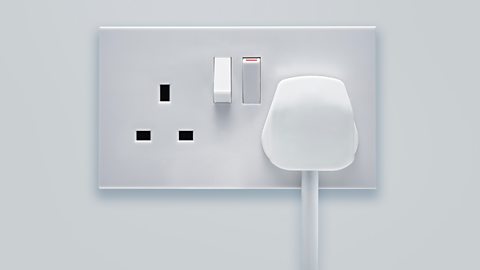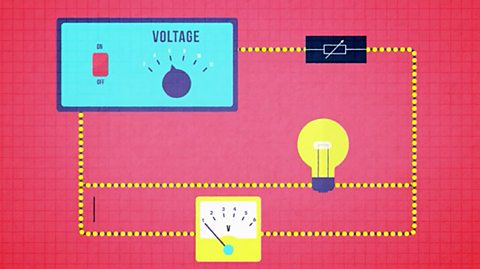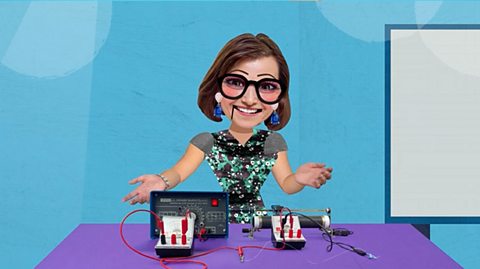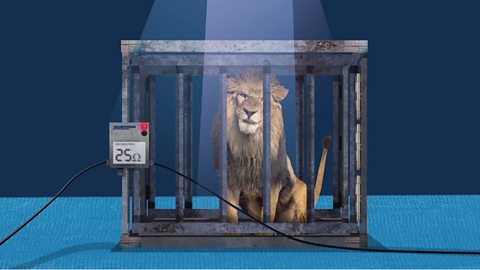What are the key learning points about electricity in the home?
The unit used in the cost of electricity to the consumer is the kilowatt-hour. One kilowatt-hour (kWh) is the energy supplied when an appliance with a power of 1kW is used for 1 hour.
A two-way switch can be used to control a light from two locations, for example on a staircase or in a long hallway.
The wiring inside a fused three-pin plug contains the live, neutral and earth wires.
Appliances with metal cases are usually earthed and the earth wire and fuse together protect the user from electric shock and the apparatus from potential damage.
Double insulation protects the user from electric shock by encasing appliances in an insulating plastic case or body.
The equation power = current × voltage can be used to calculate and select the appropriate rating of a fuse.
What is the difference between direct and alternating current?
Electricity can flow either as direct current (DC) or alternating current (AC) and is used in homes to power electrical appliances.
Direct current (DC)
Direct current only flows in one direction.
On a voltage-time graph this would appear as a straight horizontal line at a constant voltage.
Car batteries, simple cells, mobile phone batteries and solar cells all provide a direct current.
Alternating current (AC)
The electricity supply to your home is alternating current.
The National Grid distributes electricity throughout the country and this is referred to as mains electricity.
The voltage and current change size and direction in a regular way which repeats as time goes on.
On a voltage-time graph, this would appear as a curve alternating between positive and negative voltages - the positive and negative values indicate the direction of current flow.
In the UK, the mains electrical supply is generated at a frequencyThe number of waves produced each second. The unit of frequency is hertz (Hz). of 50 Hz and is delivered to houses at an average of 230 V.

How is the cost of electricity calculated for households?
Electricity companies bill customers for the electrical energy they use.
A jouleThe unit of work or energy, written as J. is much too small a unit of energy and so the electricity companies use units called kilowatt-hourThe energy supplied when an appliance with a power of 1kW is used for 1 hour, written as kWh..
One kilowatt-hour (kWh) is the energy supplied when an appliance with a power of 1kW is used for 1 hour.
Electricity companies often refer to kilowatt-hours as units so:
1 unit = 1 kWh
Domestic electricity meters measure the number of units of electricity used in a home or other building.
The more units used, the greater the cost.
The cost of the electricity used is calculated using this equation:
total cost = number of units used × cost per unit
The cost per unit is set by the electricity company, for example 30p per kWh.
This means that each unit of electricity costs 30p.
An electricity bill has two important numbers: present meter reading and previous meter reading.
The number of units used is the difference between these two readings.
Present reading = 40745 kWh
Previous reading = 39990 kWh
Number of units used = present meter reading - previous meter reading
= 40745 – 39990
= 755 kWh
total cost = number of units used × cost per unit
= 755 x 30p
= 22650p
The cost of electricity used is £226.50.
Question
Use the following information to calculate the cost of electricity used.
Previous reading = 37070 kWh.
Present reading = 38217 kWh.
Units at 30p per kWh.
Number of units used = present meter reading - previous meter reading
= 38217 – 37070
= 1147 kWh
total cost = number of units used × cost per unit
= 1147 x 30p
= 34410p
= £344.10
The cost of electricity used is £344.10.
How is the cost of using an electrical appliance calculated?
The power rating of electrical appliances can be used to calculate the cost of using them.
The following equation enables the number of units used to be calculated:
Number of units used = power rating in kW x time in hours
When using this equation it is important to remember that the power must be in kW and the time in hours.
Example
Calculate the cost of using a 2 kW heater for 6 hours if the price of a unit is 30 p.
Number of units used = power rating in kW x time in hours
Time = 6 hours
Power rating = 2 kW
Number of units used = 2 kWh x 6 h = 12 kWh
total cost = number of units used × cost per unit
= 12 kWh x 30 p
= 360 p
= £3.60
The cost of using the heater is £3.60.
Question
Calculate the total cost a using a 100 W lamp and a 300 W hair dryer for 10 minutes if a unit of electricity is 30p.
Answer
For the lamp:
Number of units used = power rating in kW x time in hours
Power rating = 100 W = \(\frac{\text{100~kW}}{\text{1000}} = {0.1~kW}\)
time = 10 minutes = \(\frac{\text{10~hours}}{\text{60}} = {0.167~hours}\)
Number of units used = 0.1 kWh x 0.167 h = 0.0167 kWh
total cost = number of units used × cost per unit
= 0.0167 kWh x 30p
= 0.5p
For the hair drier:
Number of units used = power rating in kW x time in hours
Power rating = 300 W = \(\frac{\text{300~kW}}{\text{1000}} = {0.3~kW}\)
time = 10 minutes = \(\frac{\text{10~hours}}{\text{60}} = {0.167~hours}\)
Number of units used = 0.3 kWh x 0.167 h = 0.0501 kWh
total cost = number of units used × cost per unit
= 0.0501 kWh x 30p
= 1.5p
Total cost = 0.5p + 1.5p = 2p
The cost of using the lamp and hair dryer is 2p.
Question
A TV needs 250 W.
It is switched on for 30 minutes.
If each kWh costs 30p, how much does it cost to run the TV?
Answer
Number of units used = power rating in kW x time in hours.
Power rating = 250 W = \(\frac{\text{250~kW}}{\text{1000}} = {0.25~kW}\)
Time = 30 minutes = \(\frac{\text{30 hours}}{\text{60}} = {0.5~hours}\)
Number of units used = 0.25 kWh x 0.5 h = 0.125 kWh
Total cost = number of units used × cost per unit
= 0.125 kWh x 30p
= 3.75p
The cost of running the TV is 3.75p.
How does electricity flow in a household?
In domestic devices, energy is transferred from the batteries or ac mains to the energy of motors and heating devices.
What is a one-way switch?
This type of switch is used to switch a light from just one place e.g. beside a door.
The switch operates as a make or break switch, because:
when it is turned on, the two terminals are connected and current flows.
when it is turned off, the contact between the two terminals is broken and current does not flow.
The switch is always placed in the live wire for safety reasons.
This keeps high voltage from reaching the bulb socket when the switch is in the off position and therefore makes it safer to replace the bulb.
What is a two-way switch?
A two-way switch can be used to control a light from two locations inside a house e.g. on a staircase or in a long hallway.
They are also used in school corridors so that lights can be switched from both ends of a corridor.
Two, one-way switches are joined by wires so that flipping either switch can turn the light on or off.
When both switches are up i.e. both at L1, the circuit is complete, current flows and the lamp lights.
If one of the switches, at the top or bottom of the stairs, is switched down to L2, the circuit is broken, current stops flowing, and the lamp is off.
With the switches in the positions shown in the above diagram the lamp would be off.
What are the key parts of a three-pin plug?
A plug connects a device to the mains electricity supply.
The cable between the device and the three-pin plug contains three copper wires that are coated with plastic.
Copper wires are good conductors.
Plastic is a good insulator.
Each part of the plug has a function.
| Features of a plug | Function |
|---|---|
| Outer insulation | All three wires in the cable are bundled together and there is extra plastic insulation wrapped round them all for safety. |
| Cable grip | This holds the cable tightly in place so that wires do not become loose. |
| Live wire | Copper wire coated with brown plastic along which the current enters the device. |
| Fuse | A glass or ceramic canister containing a thin wire that melts if the current gets too high. |
| Neutral wire | Copper wire coated with blue plastic that also connects to the cable in the wall and completes the circuit. |
| Earth wire | Copper wire coated in striped plastic that provides a path for current to flow from the case of the device to the ground if there is a fault. |
| Wire | Colour | Position |
|---|---|---|
| Live | Brown | Bottom Right (connected to fuse) |
| Neutral | Blue | Bottom Left |
| Earth | Yellow and Green Stripes | Top |
One way of remembering the position of the wires is:
| Colour | Position |
|---|---|
| BLue | Bottom Left |
| BRown | Bottom Right |
| sTripes | Top |
What is earthing?
Without the earth wire, if a fault occurs and the live wire becomes loose, there is a danger that it will touch the metal case.
The next person who uses the appliance could get electrocuted.
The earth pin on the three pin plug is connected by a wire to the metal body of the appliance.
This wire is connected to earth via the plug socket to a metal plate or water pipe underground.
As the wire is made of copper, the earth wire provides a low resistance path to the ground.
In the event of a fault, the live current passing through the case will follow this path to the ground instead of passing through a person.
As the earth wire has virtually no resistance, a large current flows.
This causes the fuse to blow, preventing any further current flow.
Key points
The earth wire is a safety feature.
It provides a low resistance path to earth.
What do fuses do?
A fuse provides a built-in fail-safe to the electrical circuit for a device.
The fuse contains a thin wire that will melt if the current gets too high.

If there is a fault that causes the casing of the device to become live, a large current will flow through the live wire and low-resistance earth wire.
This high current will cause the fuse to melt.
Once the fuse has melted, the circuit is broken and no more current flows through the device.
This means the case of the device is no longer live and there is no more risk of electrocution.
The fuse must be connected in the live wire side of a domestic circuit to ensure that it keeps high voltage from reaching the user, or surroundings, if a fault develops.
A fuse protects the appliance but does not protect the person using it.
It can take up to 2 seconds for a fuse to melt which is long enough for the user to be electrocuted.
Currents as small as 50 mA (milliamp) can cause electrocution and a fuse would not prevent this from flowing along the live wire.
Key points
A fuse is a safety feature for the appliance.
A fuse is connected in the live wire.
The wire inside it melts if the current is too large.
Once the fuse has melted, the circuit is broken and no more current flows.
Fuses come in various ratings, but the common sizes are 3 A, 5 A and 13 A.
The current flowing through an appliance can be calculated using the equation:
Electric power P = voltage V x current I
P = VI
Once the current is known the next highest fuse rating is chosen.
Example
A toaster has a power rating of 750 W, 230 V.
P = VI
P = 750 W
V = 230 V
750 W = 230 V x I
I = \(\frac{\text{750 W}}{\text{230 V}}\)
I = 3.26 A
The normal current for the toaster is 3.26 A.
Hence a 5 A fuse would be selected.
A 3 A fuse would “blow” when the normal operating current flowed.
A 13 A fuse would allow dangerously high current to flow and still not blow.
Question
A bed side lamp is rated 60 W, 240 V.
Calculate the size of fuse that should be fitted to the lamp for it to operate safely.
The fuse available are 3 A, 5 A and 13 A.
P = VI
P = 60 W
V = 240 V
60 W = 240 V x I
I = \(\frac{\text{60 W}}{\text{240 V}}\)
I = 0.25 A
The normal current for the lamp is 0.25 A.
Hence a 3 A fuse would be selected.
Why do switches and fuses need to be connected to the live wire?
The purpose of a switch or a fuse is to break or connect an electric circuit, but they must be correctly connected in the home.
A switch or a fuse in an electrical circuit is always connected to the live wire so that the socket or appliance is not live when switched off.
If the switch or fuse is placed in the neutral wire, the electrical appliance is still connected to the high voltage live wire even when the switch is open, or the fuse is blown.
This could cause the user to get an electric shock if they touched the inside of the appliance.
Key fact
- A switch or a fuse is always connected to the live wire.
What is double insulation?
Appliances encased in an insulating plastic case or body, such as hair dryers, mobile phone chargers and hand whisks do not need an earth wire.
Such appliances are designed so that there are two levels of insulating material between the electrical parts of the appliance and any parts on the outside that can be touched.
These two layers are normally the insulating plastic case and the insulated cable carrying the live and neutral wires.
A metal attachment, such as a whisk blade, is fitted into a plastic case so that it does not make direct contact with the internal electrical parts.
Even though the device contains a live wire at mains voltage, there are two layers of plastic separating the user from this live wire.
The symbol for double insulation on an appliance is:
How much do you know about electricity in the home?
More on Unit 2: Electricity
Find out more by working through a topic
- count1 of 5

- count2 of 5

- count3 of 5

- count4 of 5
